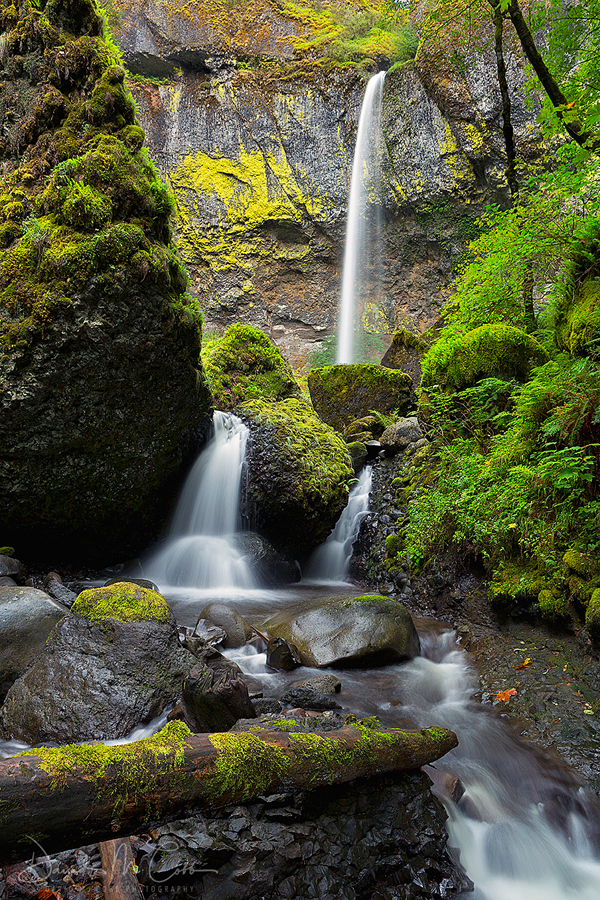
Fred Kiser first photographed this scene of McCord Creek and Elowah Falls in 1916, and it’s been comp-stomped by folks ever since – including me.
People have been trying to emulate other’s photos for a long time, often because the scene is inspiring. In 1840 Hugh Lee Pattinson took a photo of Niagara Falls, and it was one of the earliest landscape images in North America. Since then, people have been drawn to the falls continually trying to emulate that image. In painting there is a whole history of painters copying the scenes of other painters. In the Baroque era, the wealthy would travel to the countryside to view the scenes painted by Claude Lorrain. Because the landscapes didn’t look the way the painting looked, viewers would carry a dark convex lens called a “Claude glass” which would make the scenes more pleasing to the eye and so they could “see” like the painter.
In landscape photography there is a long history of people capturing a scene taken by another photographer. A recent example are the thousands of people who line up in Yosemite every February to capture Galen Rowell’s inspired image, “Last Light on Horsetail Fall.” And Rowell had followed Ansel Adams with his 1959 black and white image.
There is a difference though between influence and the blatant ripping-off of an image, and that’s called comp-stomping. The most egregious form of comp-stomping I’ve heard of involved a group of people at Palouse Falls in Washington, holding up a print of Photo Cascadia member Chip Phillips to create the exact same composition. Comp-stomping can be a useful tool for the beginner because it helps them create pleasing images and they can learn from a successful composition. In time, these beginners become more advanced and move on with their own style. I’ve taken numerous trips, because I’ve been inspired by an image and wanted to see the place for myself and photograph it in my own way.
Comp-stomping is nothing new in photography. Just look at Timothy O’Sullivan’s Ancient Ruins in the Cañon de Chelle from 1873 and compare it with Ansel Adams’ White House Ruin in Canyon de Chelly. Notice a similarity? O’Sullivan certainly influenced Adams at this location. In the western U.S., the early landscape photographers followed the painters. Some were on geological surveys with John Wesley Powell (the first photograph of The Watchman in Zion National Park in the 1870s) and others worked for the railroad.
Other landscape photographers at the time were there to capture the myth of pristine nature. Photographers Weed, Watkins, and Muybridge set up shop in the Yosemite Valley. C.L. Weed arrived first in 1859. The lesser photographer of the three, he also discovered some interesting locations to photograph. Then the superior photographers Watkins and Muybridge arrived to comp-stomp and create superior prints. C.L. Weed photographed El Capitan in 1865, followed by similar images by Watkins in 1866 and Muybridge in 1867. Weed photographed the Yosemite Valley from the Mariposa Trail in 1865 followed by Watkins in 1866, Weed photographed a giant sequoia in 1865 and you guessed it, Watson followed in 1866; and on-and-on it goes.
In the Columbia River Gorge of Oregon where I live, people have photographed here for over 150 years; with C.E. Watkins probably being the first to photograph Multnomah Falls in 1868. In 1867, he was also the first to capture that memorable view of Oneonta Gorge that so many photographers have emulated, and in addition he named the Gorge after his hometown. That impressive view of Metlako Falls which is no longer possible to photograph due to a landslide, was photographed by Clarence Winter in 1916. And that classic view of the Columbia River Gorge, Crown Point, and the Vista House from the Portland Women’s Forum? That was first photographed in 1914 by Arthur M. Prentiss before the Vista House was even constructed. We’ve been comp-stomping it ever since, but Fred Kiser probably photographed it first with the Vista House included in 1918. Kiser photographed a lot of the early images of the Columbia River Gorge and many of its’ waterfalls. The well-known view of McCord Creek and Elowah Falls was first photographed by him in 1916, and so many Pacific Northwest photographers have comp-stomped that to death ever since.
Every region around the world has its icons and many of those icons were photographed over 100 years ago. We’re still photographing them today because icons are icons for a reason—they’re beautiful. So, don’t worry about comp-stomping, even the masters did it now and again. Sometimes you need to do it to learn and sometimes those images sell because they are what the public and media buyers find familiar. There are far worse things you can do in life than take a derivative image. The next time you’re in front of an icon, try and look at it with new eyes or maybe just enjoy the scene and move on to look for something new.
“You May Think It’s New, but it’s Not” is an ongoing series and will appear in upcoming Photo Cascadia blogs, so look for future posts here.

Location: Mosier, Oregon
Website: www.dmcobbphoto.com
Facebook: www.Facebook.com/DavidMCobbPhotography
Twitter: www.twitter.com/dmcobbphoto
As a long-distance hiker, I have sharpened my photographic perspective over the years on the Pacific Crest Trail, the Continental Divide, the Canadian Divide and most recently walking across Iceland. My goal is to capture the wonders I see in nature for the enjoyment of all those with an eye for the extraordinary.

Recent Comments